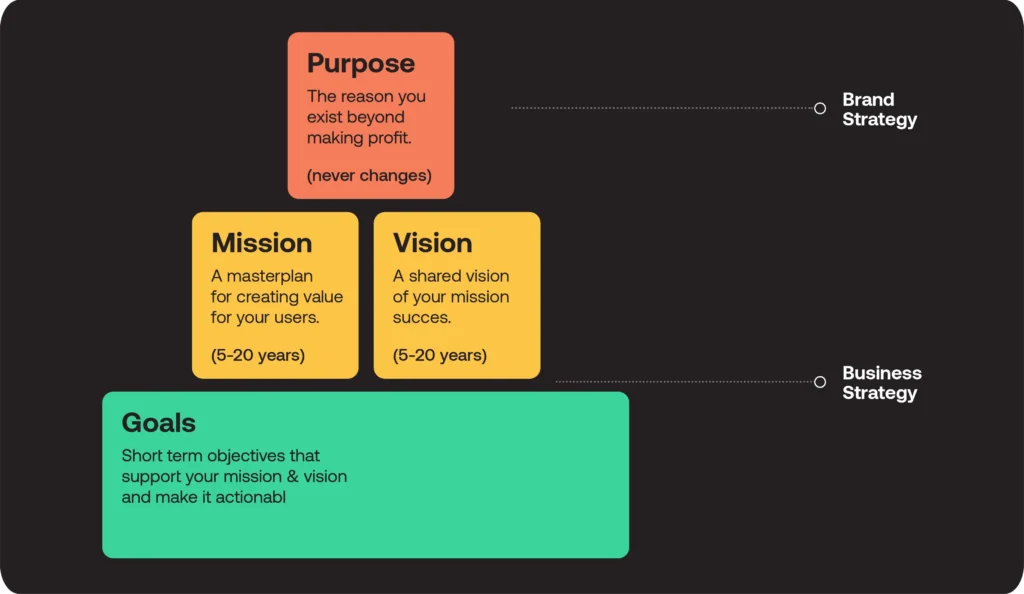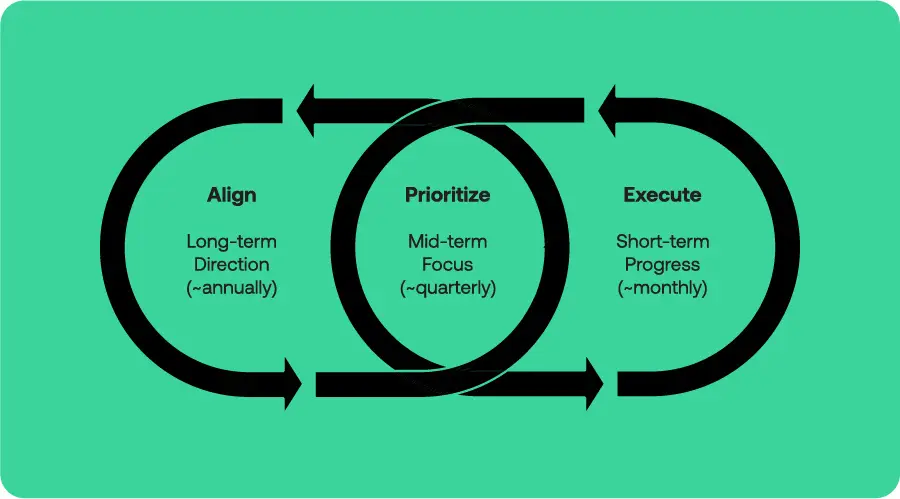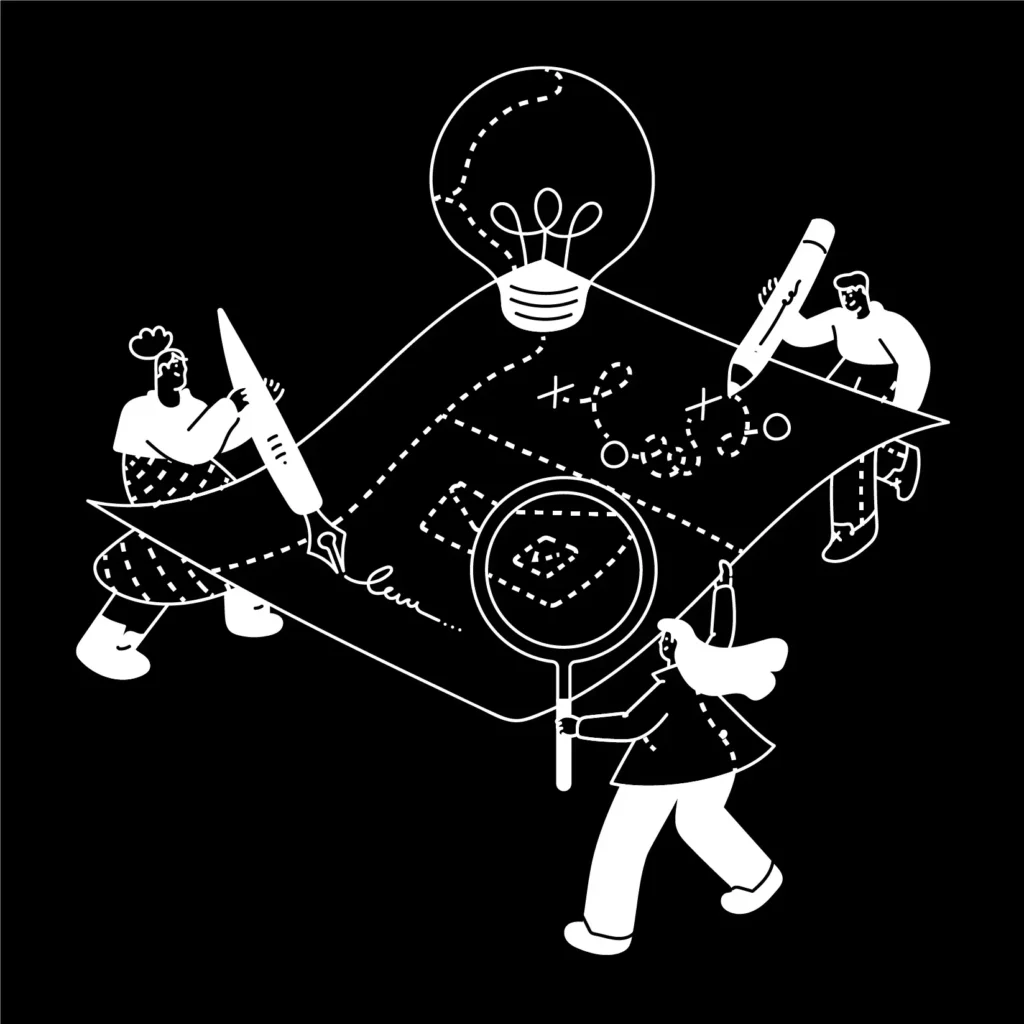The traditional approach to strategy development—which can take anywhere from 6 to 18 months (depending on the size of the company)— feels like a relic of a bygone era. There is a fundamental problem with the old way of strategising, and that is that the modern world is moving too fast. The conventional approach calls for completing a series of tasks, which often looked like this:
- Assess your current position
- Research the market for threats and opportunities
- Envision a range of scenarios
- Get agreement on a direction
- Establish a coherent vision
- Identify strategic goals
- Translate the goals into tactics
- Arrange for funding
What if we threw out the rulebook and work on multiple fronts simultaneously? We can, and it’s called agile brand strategy, something we’ve fine-tuned and honed at our consulting firm to get results faster and move quicker. Imagine this: instead of dragging your feet for 6-18 months, you could have a fully fleshed-out strategy for your business or brand in under eight weeks.
Why Pivoting Isn’t Just for Dancers
In a dynamic marketplace, the ability to pivot is your lifeline. You can’t just set a strategy and forget it; you need to be constantly reassessing based on real-world data. Forget the linear journey of ticking off tasks. What if we approached these steps as more of a dance, where each move informs the next?
Agile brand strategy yields results that are truer to your original vision. Because in this fluid approach, each task has the chance to inform and shape the others in real-time. Think of it as keeping your strategy in a constant “liquid state,” malleable and adaptable.
Contrast this with the old, sequential way of doing things, where each step is set in stone before you move on to the next. In that rigid framework, if your VP of sales stumbles upon a game-changing insight during step 7, too bad. That ship has sailed because the previous steps have already been locked in. The end result? Your strategy starts to resemble a game of telephone, each step pulling you further from your original intent.
Agile Brand Strategy in A Nutshell
Agile brand strategy isn’t just a concept; it’s a concrete framework, a blend of design thinking and strategic questioning. What’s your purpose? Who’s your customer? What’s your promise, how will you prove it, and what’s your plan? This isn’t just a checklist; it’s a dynamic roadmap that evolves with you.
Five P’s of Design Thinking:
- Pinpointing
Stating the problem
Listing the benefits of solving it
Describing the penalty for ignoring it - Idea Pinball
Thinking in metaphors
Arranging blind dates between ideas
Flipping the switch - Probing
Asking questions to gain deeper insights
Challenging assumptions
Exploring different perspectives - Prototyping
Creating tangible representations of ideas
Testing and iterating on prototypes
Learning from feedback - Proofing
Validating ideas through data and evidence
Building a case for implementation
Developing a plan for execution
Five Q’s of Strategy:
- What is our purpose?
Why are we in business beyond profit?
What are our core competencies?
Is this a worthy challenge? - Who do we serve?
What are their needs, and solutions?
How well do we know our stakeholders?
Is our target market too big or too niche? - Where should we compete?
Who are our main competitors?
Which management systems can support?
What does succes look like? - How will we win?
What makes us different?
How do we position ourselves effectively?
How to we bridge the gap? - How will we grow?
How do we elevating brand to C-level?
How do we establish an innovation center?
How do we invest in a pipeline of ideation?
The Five P’s of Design Thinking Explained
If you’re in the business of innovation, you’ve got to get past the low-hanging fruit. The five Ps are a set of principles for imagining and developing new ideas. They’re specifically designed to force your mind beyond the obvious and force thinking into new territorries. This what we call “searching for golden nuggets”.
Most folks are content scratching the surface, panning for gold in the river. It’s easy, and every now and then, you might find a small nugget. But the real treasures? They’re not in that over-panned river; they’re deep inside the mountain, in veins of gold that haven’t seen the light of day.
That’s where the five Ps come in. They’re your mining tools, designed to dig deep and unearth those hidden gems of ideas that most people won’t ever get to. So, are you happy panning in the river with everyone else, or are you ready to pick up your tools and start digging where the real gold is?
1. Pinpointing
The first step is to frame the problem correctly, or as we like to call it, “pinpointing.” Your problem statement is your North Star. Frame it wrong, and you’ll end up in the wrong galaxy. Don’t just take a problem at face value; dig deeper to uncover the root issue by posing a series of questions.
- Is this the real issue we should be tackling?
- Is it worth our top-tier resources and efforts?
- Could we be addressing other issues that would deliver greater value to our business or our clients?
This process of diagnosing the problem can be broken down into three phases:
- Clearly articulate the issue at hand.
- List the advantages of resolving it.
- Articulate the consequences of ignoring it.
2. Idea Pinball
Imagine ideas ricocheting off each other and off obstacles, much like a pinball in a machine. Now, you’ve got your problem laid out, so what are your options? We’ve got a toolkit of techniques to spark creativity, but let me share two of them:
- Metaphors
Linking two unrelated elements to create a new understanding. Let’s say you’re trying to name a new feature that automates data analytics for e-commerce platforms. You could go with something straightforward like “AutoAnalyse,” or you could think metaphorically. What if this feature was the “Spotify Playlist” of data analytics? It curates the most relevant insights for you, just like Spotify does with music. Now what could that be called? - Blind Dates
This is about smashing two unrelated ideas together to see if they click. For example, take two unrelated technologies or features and imagine them in a partnership. What happens when you combine machine learning with customer service? Or blockchain with supply chain management? Sometimes you get groundbreaking solutions like chatbots that predict customer needs. And sometimes, you get something completely useless—like combining real-time analytics with mood tracking, ending up with an emotionally aware but useless dashboard. The key is not to get too attached to your first idea; there’s a difference between being novel and being transformative. - Flipping the Switch
Assumptions are like default settings; they’re easy to overlook but crucial to performance. List all the assumptions you have about your product or service. Now, invert them. Instead of a complex dashboard that offers endless customization, what if you offered a minimalist interface that automates most choices? Instead of charging per user, what if you charged based on outcomes? Instead of looking like 99% of the B2B, what if you looked fun and playful? This isn’t just a thought exercise; it’s how companies like Slack redefined communication in the workspace.
This isn’t just to be disruptive for the sake of it; it’s to generate options you haven’t yet considered. Whether you’re launching a new feature, pivoting your business model, or scaling your startup, the goal is to broaden your strategic horizon and discover untapped opportunities.
3. Probing
Alright, let’s talk about the art of probing, a stage where you and your team dissect those freshly minted ideas to see what’s really there. You might be familiar with Edward de Bono’s “Six Thinking Hats”. The concept is simple: parallel thinking. Everyone in the room is aligned, focusing in the same direction at the same time. You’re not playing devil’s advocate; you’re all wearing different hats—literally and metaphorically. So take ideas from the Idea Pinball phase, and pass it around in the group, wearing different hats.
- First up, the White Hat. This is where you bring in the cold, hard but helpful data. We’re talking churn rates, customer lifetime value, marketing data, sales patterns and your latest NPS scores. No opinions, just facts. This sets the stage, giving everyone the same foundational understanding of what you’re dealing with. Note you aren’t suggesting any ideas or solutions.
- Switch hats to Red. Now, forget the data. How does the idea make you feel? Excited? Terrified? Both? Good, jot those emotions down. Don’t underestimate the power of gut reactions; they often unearth insights that data can’t. In other words, people make better decisions when they confront their emotions at the start rather than cloaking them in rational.
- Yellow Hat time. This is your ‘what if everything goes right’ scenario. It’s not about being naive; it’s about understanding the full scope of opportunity. What could this idea become if all the stars align?
- Now, let’s get critical with the Black Hat. This is where you poke holes in your idea. And let’s be honest, in the SaaS world, there are plenty of pitfalls—be it scalability issues, data security, or just plain market saturation. List out everything that could go wrong. This isn’t pessimism; it’s strategic caution.
- Finally, the Green Hat. This is where you turn problems into solutions. You’ve identified the risks with the Black Hat; now, how can you mitigate them? What features or safeguards could you implement? This is where innovation thrives.
- And let’s not forget the Blue Hat. That’s for whoever’s steering the ship, deciding which hat the team should wear and when. It’s like the Scrum Master in your agile methodology—someone has to keep the process on track.
This isn’t just an exercise in creativity; it’s a structured approach to problem-solving. And in the fast-paced world of SaaS, where features can be rolled out in weeks and pivots happen in days, this kind of rigorous, multi-faceted thinking isn’t just useful; it’s essential. So, go ahead, put on your thinking hats.
4. Prototyping
The secret sauce that elevates design thinking above normal brainstorming sessions. In the SaaS universe, where the line between idea and execution is often thin, prototyping is your bridge from theory to application. It’s not about recycling old strategies; it’s about using first principles as your guide.
First principles thinking is a method of problem-solving that breaks down complex issues into their most basic elements. A concept rooted in physics, but widely adopted in various fields. These foundational truths are then used to reconstruct a solution tailored to specific challenges. In the SaaS context, it allows for innovative, custom strategies that sidestep industry norms.
What’s a prototype? Think of it as your idea’s first incarnation. It could be as simple as a sketch, a wireframe for a new feature, a user journey map, or even a quick financial model projecting MRR growth. The point is to throw it together fast, and then—this is crucial—learn from it. Iterate. Refine. Go another round. This is agile methodology on steroids.
Now, who’s in charge of prototyping? Typically, it’s your designers, your content creators, and your data analysts. These are the folks who’ve spent years honing their skills to work swiftly and instinctively. But anyone can sketch out an idea or cobble together a rudimentary model.
5. Proofing
Prototypes or beta versions are your reality check. They offer a tangible way to test your hypotheses on real users, giving you actionable insights. But nonetheless the process is prone to assumptions that can lead you astray. That’s where proofing comes in—your test against market realities.
Here’s a pro tip: Don’t just test one prototype; put multiple versions in the ring. A single prototype forces a binary yes-or-no judgment. Multiple versions, however, spark a conversation about each one’s up and downsides, especially within your team. The goal isn’t a simple go but an ongoing dialogue that refines your strategy.
Now, let’s address something important: the notion that your ideas are so brilliant they should sell themselves. Two assumptions are baked into this mindset. First, the belief that ideas are products to be sold, positioning you as the seller and your team as passive buyers. In truth, groundbreaking ideas aren’t sold; they’re adopted by those who see their potential. Second, the claim that your ideas are inherently great. I hope this perspective is fueled by your expertise, which your team may not share. The more radical your idea, the more resistance you’ll face. So, how do you overcome this?
Craft prototypes. Test them rigorously. Gather data. Refine your concept. And most importantly, show your journey to paint a picture of what success looks like. R
So, how do you translate all this into a viable strategy for your SaaS venture? By applying these principles of design thinking to the following questions.
The Five Q’s of Strategy Explained
In the past, business strategy was the domain of the C-suite, while brand strategy, if it even had a seat at the table, was part of the responsibilities of the marketing department. Today however, business and brand strategy are linked like two strands of a DNA helix. One strand represents the internal—the nuts and bolts of how you function. The other the external—how the market perceives you.
In our current customer-centric landscape, any SaaS company that doesn’t place its users at the core of its strategy is on a fast track to become obsolete. You can’t afford to separate business modeling from brand framing anymore. They’re two sides of the same coin.
The Five Qs of strategy—purpose, customer, category, positioning, and culture—serve as your beacons whether you’re sculpting your business model or crafting your brand narrative.
1. Purpose
Any strategy starts with purpose. Without it, leaders will jump ship at the first sign of turbulence, and employees mentally check out long before they physically exit. A well-defined purpose is knowing where you want to march towards; it energizes your team and resonates with your customers. So, how do you articulate this purpose? You ask the hard questions:
- Why are we in this game beyond just turning a profit?
- What change are we trying to catalyze in the world?
- What gets us out of bed in the morning?
- What are we exceptionally good at?
- Is there a genuine need for our product?
- Is this challenge worthy of our time and talent?
- Is our purpose broad enough to adapt to future ambitions?
A purpose isn’t a tagline you change with the seasons; it’s a constant. Once you’ve nailed it down, it becomes the bedrock of your culture, mission, and vision. It’s your yardstick for progress.
Now, let’s dispel a common myth: Purpose, mission, and vision are not synonyms. Think of your strategy as a three-tiered pyramid.

At the top is your purpose—the immutable reason you’re in business beyond just making a profit. Change your purpose, and you’re essentially a new company.
The middle tier houses your mission and vision, which both serve your purpose. Your mission is your objective to fulfill that purpose. Your vision is how you see that mission coming to life. For instance, Microsoft’s mission was to ‘lead the personal computer revolution,’ but its vision was ‘a computer on every desktop and in every home.’ These are your mid-term goals, with a lifespan ranging from five to twenty years.
At the base of the pyramid is where your tactics live—these are your short-term goals, achievable in one to three years, designed to drive you toward your mission and vision. Don’t craft your purpose by itself. It should be in accordance with all elements of your strategy, ensuring a cohesive narrative.
2. Who Do We Serve?
Who are you really serving? If your answer is investors, you’re missing the point. Your customers aren’t just users; they’re your tribe. So, who makes up this tribe? What’s their common language? How do they interact? What are the tribal norms? These are not trivial questions; they’re foundational. Your tribe is the lifeblood of your SaaS startup or scaleup.
To visualise this relationship we like to use Marty Neumeiers “Infinity Loop.” Here’s how it works: Management empowers employees, employees delight customers, satisfied customers attract investors, and investors back the management. Notice how investors come last? They’re the outcome, not the starting point. Your primary focus should be on nurturing this customer tribe; everything else is a byproduct and logical outcome of the previous.
To get a grip on your tribe, envision your ideal customer. We often use a thought exercise: Identify a keynote speaker who embodies your brand values and mission. This person is more than just a spokesperson; they’re your brand advocate, your tribal leader.
But how can you know who your tribe is if you’re still fuzzy on what you’re offering? This is where the iterative process comes in. You start somewhere—anywhere—and refine as you go, constantly checking your assumptions against the five critical strategy questions.
3. Where should we compete?
Where you choose to compete isn’t just a matter of throwing darts at a board. The category you pick is as crucial as the code you write for your software. So, how do you decide where to plant your flag?
First off, you might already be in a category that aligns with your purpose. If so, great. But if your starting point is broader, then you’ve got some searching to do.
Here’s a checklist of questions you need to tackle:
- Do you have the skill set to compete in this category? If not, can you acquire it without burning through your runway?
- Do you have existing credibility in this space? If you’re pivoting, how will your current customer base react?
- Does this new product or service create synergies with your existing product suite, or is it a distracting sideshow?
- Are you ready to go toe-to-toe with established brands? If you’re entering a red ocean, what’s your shark repellent?
- What kind of backend systems will you need to support this new direction? Is your current tech stack up to the task?
- Can you afford to do this well? Doing something half-baked is often worse than not doing it at all.
- What does victory look like? Can you define success in a way that aligns with your overall strategy?
Choosing where to compete is a strategic decision with long-term implications. Don’t just follow the herd; make a calculated move. Your category isn’t just a market segment; it’s the arena where you’ll either thrive or get eaten alive. Choose wisely.
4. How Will We Compete?
Why should customers pick your SaaS solution overothers? If you’re simply thinking “our product is better”, it’s time for a reality check. Customers often can’t discern quality differences; they rely on secondary cues like user reviews, price popularity or social proof. Performance based facts are a lot less persuasive for customers than you would like to think.
And if you’re thinking, “because we’re cheaper,” you’re missing the essence of branding. Branding isn’t a race to the bottom; it’s about commanding a premium because people believe you’re worth it. Unless you’re the Dollar Store of SaaS, discounting isn’t a sustainable strategy.
The brands that win aren’t necessarily better or cheaper; they’re distinctively different. And not just different for the sake of being quirky, but different in a way that resonates with your target audience. This is what we call positioning. It’s not about dictating customer preferences; it’s about aligning your offerings and messaging so that you occupy a favorable position in the mind of the customer.
Here’s a test: the “Onlyness Statement.” Fill in the blanks: “Our brand is the only [your category – see Q number 3] that [your unique differentiator].” If you can’t complete the sentence with something compelling, you’re not just lacking a tagline; you’re lacking a strategy.
But let’s be clear: a killer positioning statement isn’t the finish line; it’s the starting point. Building a brand is a two-step dance: first, nail the right idea; second, execute that idea flawlessly. It requires an interplay of specialists, both internal and external, all playing in tune to create a brand that’s not just coherent, but compelling. So, what’s your “onlyness”? Once you figure that out, the real work begins.
5. How Will We Grow?
Some companies just get lucky—right place, right time, but no replicable strategy for success. For every one of these, there will be 49 that nobody has ever heard about. And let’s not even talk about the ones that burn before they even get a chance to pivot, the ones that will be irrelevant in 5 years. If you want to be in the game long-term, you need more than luck or even a killer product. You need a culture of relentless innovation.
Think of it as the “flywheel effect.” A well-calibrated culture can take a small input of innovative energy and amplify it into significant business momentum. But don’t kid yourself; telling your team to “think outside the box” won’t cut it. You need structural changes that foster innovation. Here are five shifts that can make a tangible difference:
- Elevate Branding to the C-Suite: Stop treating your brand like it’s a subset of your marketing department. Appoint a Chief Brand Officer (CBO) whose sole focus is to manage every touchpoint with your customer tribe. This isn’t a side gig for your CMO; it’s a full-time job.
- Create an Innovation Hub: Whether it’s a physical lab or a digital workspace, create an environment where creativity isn’t just encouraged; it’s expected. This is your in-house incubator for ideas that could pivot your entire business.
- Invest Like a VC: Your innovation pipeline should resemble a venture capitalist’s portfolio. Use a stage-gate process to vet new ideas. Start with seed funding for concept development, then scale your investment based on milestones. The mantra here is: think big, bet cautiously, scale wisely.
- Implement Branded Training: Your competitive edge isn’t just what you do; it’s how you do it. Train your team not just in the skills they need, but in the unique methodologies that make your company different.
- Reward Creativity: Make it clear that innovation isn’t just accepted; it’s celebrated. And rewards don’t have to be monetary. Sometimes, the best incentive is the promise of more exciting projects or even career advancement.
Example User Case
Now, let’s dive into a concrete example of implementing the five Qs and five Ps in a fictional business case. Really look at it
Business Case: SaaS Startup for Remote Team Collaboration
The Five Qs:
- What is our purpose?
- To simplify remote team collaboration and enhance productivity.
- Where are we now?
- MVP developed, initial user feedback collected, small customer base.
- What could we do?
- Optimize the product based on feedback, expand features, target new customer segments.
- What will we do?
- Focus on AI-driven features to automate repetitive tasks in team collaboration.
- How will we do it?
- Agile development cycles, customer feedback loops, and targeted marketing campaigns.
The Five Ps:
- Problemizing:
- Problem Statement: Our product lacks AI-driven features, making it less competitive.
- Solution Benefit: Implementing AI can automate tasks, making the product more appealing.
- Opportunity Cost: Without AI, we risk losing market share to more innovative competitors.
- Pinballing:
- Metaphor: Our product should be the “Slack meets AI” of team collaboration.
- Blind Dates: Combining AI with real-time collaboration.
- Reverse Polarity: Instead of users adapting to the tool, the tool adapts to the users through AI.
- Probing:
- White Hat: Data shows a 30% increase in demand for AI-driven collaboration tools.
- Red Hat: Excitement about being an innovator in the space.
- Black Hat: Concerns about data privacy with AI.
- Prototyping:
- Develop a minimal viable feature set for AI-driven functionalities.
- Proofing:
- Test the prototype with a small user group, gather feedback, and iterate.
By applying the five Ps to the five Qs, the SaaS startup can develop a more agile, responsive, and effective strategy for scaling its remote team collaboration tool. The beauty is that the trickle down effect of purpose can be used on different scales of internal and external problem solving.
Embrace the Pivot
Think of your strategy as holding a drum stick. You don’t grip it too tight but hold it with a certain finesse, ready to adapt to the rhythm of market dynamics, audience behavior, emerging insights, and your competitors. In another metapfor, your planning are guidelines, it’s not a prison that you can’t escape. This is the definition of being agile in your brand strategy, be ready to change direction slightly if you get strong signals externally or internally.

A strategy isn’t a set-it-and-forget-it mechanism. It’s more like a living, breathing entity that needs constant nurturing to keep it thriving. Ignore the market signals, and you’re playing to an empty room. Disregard your audience’s changing tastes, and you’re drumming to a beat no one wants to dance to.
So, what’s the game plan? Listen, learn, and be prepared to pivot. Your strategy should be fluid, informed by a continuous loop of feedback and adaptation. It’s not about tearing up the rulebook every time something changes; it’s about fine-tuning your approach to resonate with the ever-changing nuances of the landscape.
For a deeper dive into fostering a culture of innovation and the power of strategy you might want to check out our other blog posts. But for now, remember this: innovation isn’t a department; it’s a mindset. And it’s the closest thing you’ll get to a guarantee of long-term relevance and growth.




